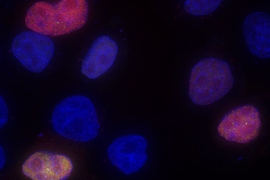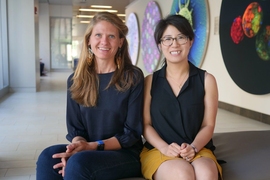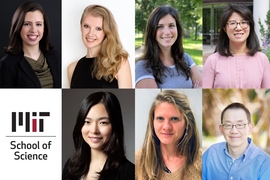Seychelle Vos arrived in September 2019 as the Department of Biology’s newest assistant professor. Her lab in Building 68 uses cryogenic electron microscopy (cryo-EM), X-ray crystallography, biochemistry, and genetics to study how DNA and its associated proteins are organized inside the cell. Vos received her PhD from the University of California at Berkeley and completed her postdoctoral research at the Max Planck Institute for Biophysical Chemistry in Germany. She sat down to discuss her structural biology research, and why it’s so important to understand DNA as a physical structure.
Q: Your research is on the proteins that compress DNA so it can fit inside a cellular organelle called the nucleus. How does the genome organize itself in different shapes to perform different functions in the cell, and why is this an important process for us to understand?
A: If we take all the DNA inside of one human cell and stretch it out end to end, it extends 2 meters in length. But it needs to fit into the nucleus, which is only a few microns wide. It's essentially like stringing a fishing line from here to New Haven and trying to put it in a soccer ball. That's not an easy thing to do. There are lots of proteins that compact the genome either by wrapping the DNA around themselves or by forming loops in the DNA.
In order to replicate DNA or transcribe it to make a protein, the cell’s molecular machinery needs to be able to access and read it. Depending on how the DNA is wrapped and organized, different genes will be more accessible than others. In a stem cell, essentially any gene can be turned on. But as cells begin to differentiate into kidney cells, liver cells, and so on, only the genes specific to those functions can be turned on. Every cell has its own set of proteins that make it special, and most of that regulation happens at the level of RNA expression.
Our lab wants to understand how DNA organization impacts gene expression at the atomic level. This gets to the crux of how a stem cell becomes a specific cell type, and what happens when those programs go wrong. Without the right kind of compaction you can have cancer phenotypes, because things get turned on that shouldn't be, or a cell thinks it's a stem cell again and divides really fast. Many of the proteins we study are involved either in developmental disorders or cancers. If we don't understand their basic biology, it's very hard to come up with reasonable ways of treating these diseases.
Q: What was it about structural biology that hooked you during your early career?
A: When I started my PhD at UC Berkeley, I didn't have much of an interest in structural biology. I thought that I wanted to study the immunology of nucleic acids, and I did my first lab rotation with Jennifer Doudna, one of the biochemists who was instrumental in developing CRISPR-Cas9 as a gene-editing tool. She might seem like a funny first person to do a rotation with if you were doing immunology, but CRISPR is essentially a bacterial immune system, and I went to her lab just to see a completely different way of viewing immunology. During that rotation, I fell in love with crystallography. What's so beautiful about this technique is that it shows us how different atoms are communicating with each other, and how one molecule might be engaging with another molecule.
For the rest of my rotations as a graduate student, I did research in biochemistry and structural biology labs, and ended up joining James Berger’s lab, which did a combination of both. I worked on a class of enzymes called topoisomerases that bind to DNA and uncoil the DNA when it gets tangled. I was able to solve a number of very interesting structures, and do biochemistry and genetics all at the same time.
During my postdoc I studied RNA polymerase II, the enzyme that makes all the RNAs that turn into proteins in the cell and determine the cell’s identity. I wanted to know how it is regulated after the initiation stage of transcription. One of the proteins I was working with wouldn’t crystallize, and we had to come up with some other ways of seeing it. So we turned to cryo-EM, which had just become a very high-resolution technology — we could actually see the atoms touching each other! That was a game-changer for me. If you told me at the beginning of my PhD that these technologies could become central to my research, I would have told you there's no way that would happen. But life has surprises.
Q: How does your expertise in genetics and biochemistry help you solve structural problems?
A: I'm definitely not your average structural biologist — I use structural tools to advance the genetics I want to do. My lab uses genetics to inform which protein complexes we want to look at, and then we use cryo-EM and X-ray crystallography to understand how those proteins actually affect RNA polymerase II. With what we learn about the structure, we can go back and use targeted genetic approaches to remove those proteins from the genome and see what happens to gene expression in particular cells. I also have projects where we’ll do a genetic screen first, and then use structural biology and chemistry techniques to get more information. The research is like a giant feedback loop. You need all of those perspectives to really understand the whole system.










